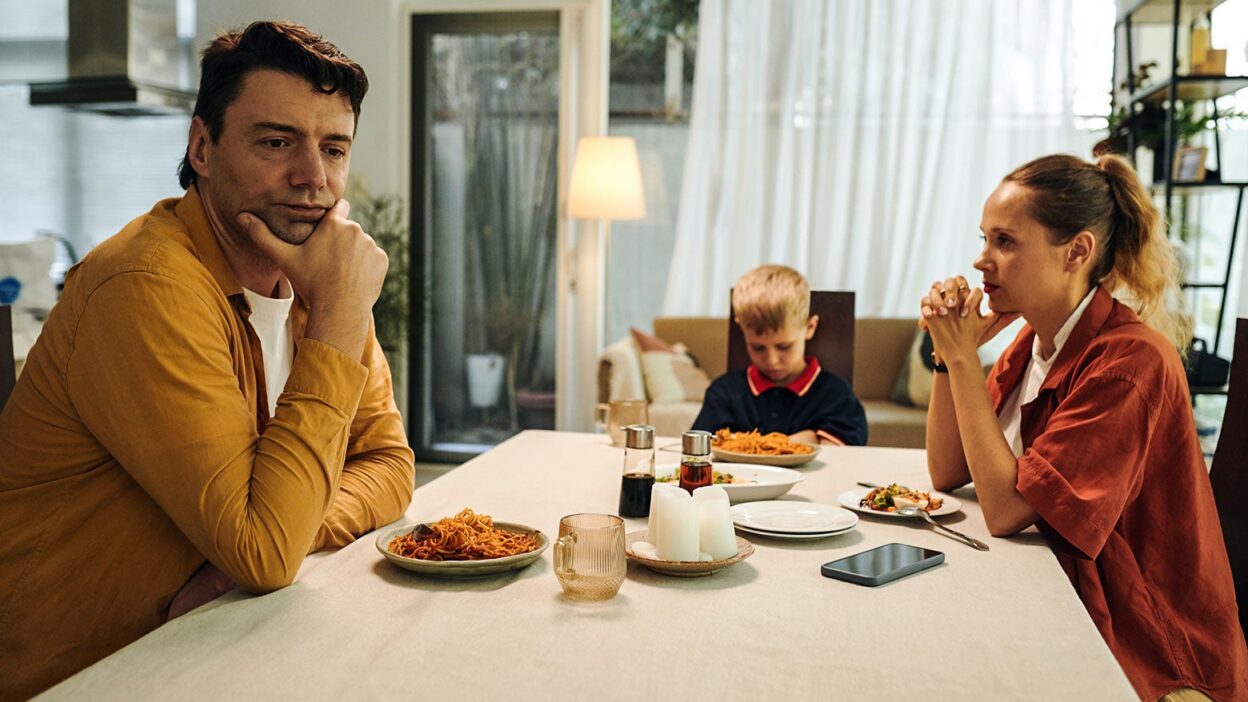Sign up for the Slatest to get the most insightful analysis, criticism, and advice out there, delivered to your inbox daily.
Most nights of the week, my husband eats dinner around 3 p.m. due to health reasons. In the evening, I scarf down a quick meal (often a sandwich) with my 7-year-old, then I feed my fussy 2-year-old separately. This arrangement results in the fewest tears from both adults and children. Yet, I can’t shake the feeling that we’re somehow doing it wrong.
Every once in a while, I’ll find a news article or public health campaign presenting family dinners as a cornerstone of good parenting—almost as if it were a kind of magic bullet for raising happy, healthy kids. Research has linked it to better nutrition, improved academic performance, and a lower risk of substance use. It apparently even lowers children’s risk of teen pregnancy. Some articles like this paint family meals as a kind of sacred ritual, one that must be protected at all costs, not just to set your child up for lifelong success, but also to uphold cultural values and secure the increasingly fragile family bonds that are being eroded by modern influences like screen time.
Despite the glowing reputation of the nightly family dinner, a 2022 survey found that the tradition is steadily fading with each subsequent generation. Although 76 percent of baby boomers grew up eating meals with their families every day, only 46 percent of millennials and just 38 percent of Gen Z report having the same experience. The decline isn’t a result of disbelief in its benefits—62 percent of parents say they want to have more frequent family meals. But making it happen is another story.
For Richard Robbins and his wife, parents of nine living in Tennessee, traditional sit-down meals once worked for their family but soon became unmanageable as their children’s schedules got busier. “With kids ranging from 18 years old to a newborn, our schedule around dinnertime is always hectic,” writes Robbins in an email interview. “Our kids are all involved in so many activities (sports, music lessons, church activities) during the afternoons and evenings, that it has become nearly impossible to sit down and eat together.”
It’s not just clashing work calendars and after-school chaos that are making family dinners tricky. Parents I spoke to shared a range of other challenges complicating mealtimes. Some are juggling different dietary needs within the family, while others have health issues that require some members to eat at odd hours.
Then there’s the universal barrier facing all parents: Getting meals on the table feels like the second shift after your actual full-time job. What we can see—the grocery shopping, preparing ingredients, cooking, and cleaning up—is only part of the hassle. Georgia Middleton, a researcher at Flinders University who studies shared eating occasions, says many don’t realize the invisible mental work required for a delicious and nutritious spread. She easily fires off a list of considerations for a typical meal: “What are you going to serve? Who’s allergic to what? … How long is this going to take? How much is it going to cost? Is it healthy enough? Is there enough variety? Is everybody going to enjoy this meal?” Once the nutritious, home-cooked meals are whipped up, there’s also the unseen work of managing emotions around the table (including those strong ones coming from a sobbing toddler whose peas touched the rice).
With modern life pushing us toward more-fragmented eating arrangements, we face an important question: Are we—by which I also mean myself and my husband!—depriving children of a crucial developmental experience if family meals aren’t a regular part of their lives?
There is no dispute that numerous studies, like the ones I describe above, link shared family meals with positive outcomes for kids. But several experts have questioned the strength of the relationship and whether family meals are a direct cause of those outcomes.
When Middleton and her team reviewed existing research by analyzing multiple studies together, they found that the evidence was shakier than expected. Many studies didn’t account for other crucial factors that can affect child outcomes (such as physical activity or sleep). They also defined positive outcomes differently, so direct comparisons between studies would be unfair. Her conclusion? Until we’re able to gather more accurate data, there are still too many unknowns. “We weren’t able to provide a definitive answer to the question Are family meals beneficial to these kinds of health outcomes?” says Middleton. Other research has even indicated that family meals have no significant impact on academic and behavioral outcomes.
Given the ambiguity of these findings, another group of researchers asked: What if the “magic” behind family meals has more to do with the bonding that happens around it? They focused on teens, examining how family dinners were linked to factors such as school performance and risky behavior. It turned out that context mattered. “If you’re not measuring and accounting for factors related to family connectedness, then you are more likely to find significant relationships between family meals and those adolescent outcomes,” says Samantha Goldfarb, lead author of the study and an expert in child health policy at Florida State University. “Once you add in family-connectedness factors … that significance between the family meal itself and the outcome starts to weaken.”
In other words, the fact that these kids are doing well across various areas might not be due to family meals alone. They’re likely benefiting from something deeper: the strong family bonds that are built around the regular routine together.
Does this mean that family dinners aren’t valuable? Not quite. It simply means we might be overestimating their unique power if we’re not considering the bigger picture of what family life is like.
Unfortunately, this lack of nuance in understanding family meal benefits has seeped into public health messaging—creating a scattered approach to recommendations. “Promotion is very broad, and it’s saying: Any one of these things could be the most important thing,” explains Middleton, adding that it often feels as if families are encouraged to improve everything at once, with the hope that something will make a difference.
A list of nine well-meaning recommendations around the “family table” from the American College of Pediatricians exemplifies this, with suggestions like “Require that everyone stay at the table until all family members have finished” and “Turn off the television, computer, and all personal digital devices.” Few would argue with the individual suggestions. But taken together, the advice can feel unrealistic and out of touch with the barriers faced by today’s parents. Rather than inspiring parents to whip up nutritious meals for the whole family, what we end up with is more advice that feels overwhelming.
These overly idealized family-meal recommendations also create another problem: unnecessary parental guilt. Parents are already worried enough about managing screen time, guaranteeing school safety, and ensuring that their kids are equipped to keep up in a world transformed by A.I. (Forty-one percent of parents report feeling so stressed they cannot function most days.) Is guilt around family meals something we really need to add to their plates?
When messaging around family meals oversimplifies the research, focusing on the act itself without explaining deeper factors like connection and parental presence, it may create unnecessary worry that children might not flourish if daily dinners aren’t screen-free, home-cooked, and filled with meaningful conversations. In reality, many parents are doing just fine and are finding their own unique ways to bond and nourish their kids in ways that don’t always involve a shared dinner table.
Hilary Hodge, a mother of one, believes we need to embrace more varied narratives around parenting instead of focusing on “this one that we tend to get from Instagram parents—predominantly moms having … beautiful little snack trays with caprese salads that look like ladybugs.” Hodge, who has a chronic health condition that makes shared meals tricky in her household, notes: “We don’t all have time to do that, and that doesn’t mean we can’t be wonderful parents.”
So what would be a realistic way for today’s parents to think about family dinners? Experts aren’t suggesting that we abandon the goal of eating together. After all, a shared meal can be a natural point in the day for many families to reconnect and share something nutritious together. What researchers are suggesting, however, is to rethink how these rituals are viewed and promoted within the context of our modern era.
Rather than upholding family dinners as the gold standard of good parenting, we should see them for what they truly are—one of many ways to nurture healthy kids and build strong family connections. For some families, dinner might be the best time to check in and bond. For others, it might be before bedtime or on a weekend outing. As Goldfarb puts it, family meals are just one opportunity for parent–child connection, but “it doesn’t have to be the only way.”
And if you’re worried that your family meals aren’t always looking like something out of a 1950s sitcom, don’t be. Middleton urges parents to take a bit of the pressure off themselves. “Not all meals have to be perfect,” she says, adding that convenience options are not off the cards either. And if some meals flop, that’s totally normal too. “Focus on … one or two really quality family-focused meals a week … then ease the pressure on the rest of the week. Try to hit the targets where you can, but don’t stress too much. We don’t know which part of the family meal is the most important.”
To ease her own anxiety around family meals, Olivia Howell, a single mom of two boys, uses two simple overarching goals to guide this hectic part of the day: Everyone eats something so they’re not hangry, and we find time to connect. In her household, this could mean eating dinner together on the couch with a Disney movie on. But if a day has been particularly hectic for everyone, she tunes in to that and ensures that everyone gets the space they need. “Other nights, we’d all eat in different spots around the house because we needed some decompression, and then reconnect later with cuddles and a bedtime book. That still counts as quality time,” explains Howell.
Family dinners can be a great way to work nutrition and connection into your child’s day. But if it doesn’t fit well into your family’s rhythm, know that your kids can still thrive. For our household, we’ll probably keep eating in shifts for now. But the dream of calmer, shared dinners isn’t off the table. Maybe once my kids can get through a meal without a full-blown dispute about accidental foot contact, we’ll try again.




